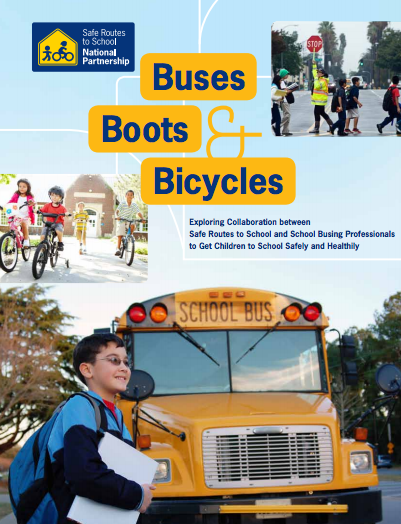 In June 2013, the American College of Sports Medicine released their most recent fitness ranking of the 50 largest US metropolitan areas.
In June 2013, the American College of Sports Medicine released their most recent fitness ranking of the 50 largest US metropolitan areas.
Resource Library
This webinar from February 20, 2014 discusses how to choose and implement the best bicycle safety curriculum for your community.
This policy briefdescribes research showing the benefits of physical activityfor student learning, explains the state requirements andstandards for P.E., highlights board actions to support P.E.and lists additional resources board members and othersmight find useful.

 "We can never be satisfied as long as our children are stripped of their self-hood and robbed of their dignity."
"We can never be satisfied as long as our children are stripped of their self-hood and robbed of their dignity."
In a March 2012 research brief, Impact of State Laws on Walking and Bicycling to School, Active Living Research was the first to examine the impact of state laws on walking and bicycling to school among a national sample of elementary schools in the United States.
 After Congress and the President were unable to agree on a deal to continue funding for federal agencies and programs through the annual appropriations process, the federal government was shut down and non-essential employees were sent home. The shutdown is now in its second week, and there is no sign of progress towards a resolution.
After Congress and the President were unable to agree on a deal to continue funding for federal agencies and programs through the annual appropriations process, the federal government was shut down and non-essential employees were sent home. The shutdown is now in its second week, and there is no sign of progress towards a resolution.
 October is such a great time of year. And I love International Walk and Bike to School Day which its taking place this year on October 9! There is so much to celebrate during this October, here is my top five list:
October is such a great time of year. And I love International Walk and Bike to School Day which its taking place this year on October 9! There is so much to celebrate during this October, here is my top five list:
Safe Routes to School (SRTS) programs can help reduce schools’ risk of liability while making it safer for students to walk or bike. This fact sheet explains why liability fears shouldn’t keep schools from supporting SRTS programs, and offers practical tips for schools and community advocates
 On November 2, bicycle advocates in Fairfax County, Virginia came together for the second Fairfax Bike Summit hosted by the Fairfax Advocates for Better Bicycling (FABB).
On November 2, bicycle advocates in Fairfax County, Virginia came together for the second Fairfax Bike Summit hosted by the Fairfax Advocates for Better Bicycling (FABB).
These briefings sheets were developed with funding support from the National Center for Safe Routes to School. The briefing sheets are intended for use by transportation engineers and planners to support their active participation in the development and implementation of Safe Routes to School programs and activities.

Co-Authors:
Eric Bruins, Los Angeles County Bicycle Coalition
Jessica Meaney, Southern California Policy Director, Safe Routes Partnership
These briefings sheets were developed with funding support from the National Center for Safe Routes to School. The briefing sheets are intended for use by transportation engineers and planners to support their active participation in the development and implementation of Safe Routes to School programs and activities.
 The Portland, Oregon region, in many regards, is ahead of the curve when it comes to active transportation. The “Bike Bill” (ORS 366.514), passed more than 40 years ago by the Oregon Legislature in 1971, requires the inclusion of facilities for pedestrians and bicyclists wherever a road, street or highway is built or rebuilt.
The Portland, Oregon region, in many regards, is ahead of the curve when it comes to active transportation. The “Bike Bill” (ORS 366.514), passed more than 40 years ago by the Oregon Legislature in 1971, requires the inclusion of facilities for pedestrians and bicyclists wherever a road, street or highway is built or rebuilt.
This article analyzes the variation in bike commuting in large American cities,with a focus on assessing the influence of bike paths and lanes.
 There were two significant developments this month in Washington D.C for Safe Routes to School. First, the U.S. Department of Transportation (USDOT) released its proposed rule addressing safety on our roads.
There were two significant developments this month in Washington D.C for Safe Routes to School. First, the U.S. Department of Transportation (USDOT) released its proposed rule addressing safety on our roads.
This planning manual illustrates why planning for transit-oriented development that serves families is important for creating complete communities and how such integrated planning can be achieved.
Regular physical activity can reduce children’s risk of obesity and improve their classroom performance, but many schools provide few opportunities for students to be active. Schools can provide excellent opportunities for children to be physically active through regular recess.
 Today, most student transportation departments around the country focus primarily on getting students to school on yellow school buses. But student transportation isn’t just about school buses. Students are also getting to school by foot, bicycle, car, and public transportation.
Today, most student transportation departments around the country focus primarily on getting students to school on yellow school buses. But student transportation isn’t just about school buses. Students are also getting to school by foot, bicycle, car, and public transportation.

